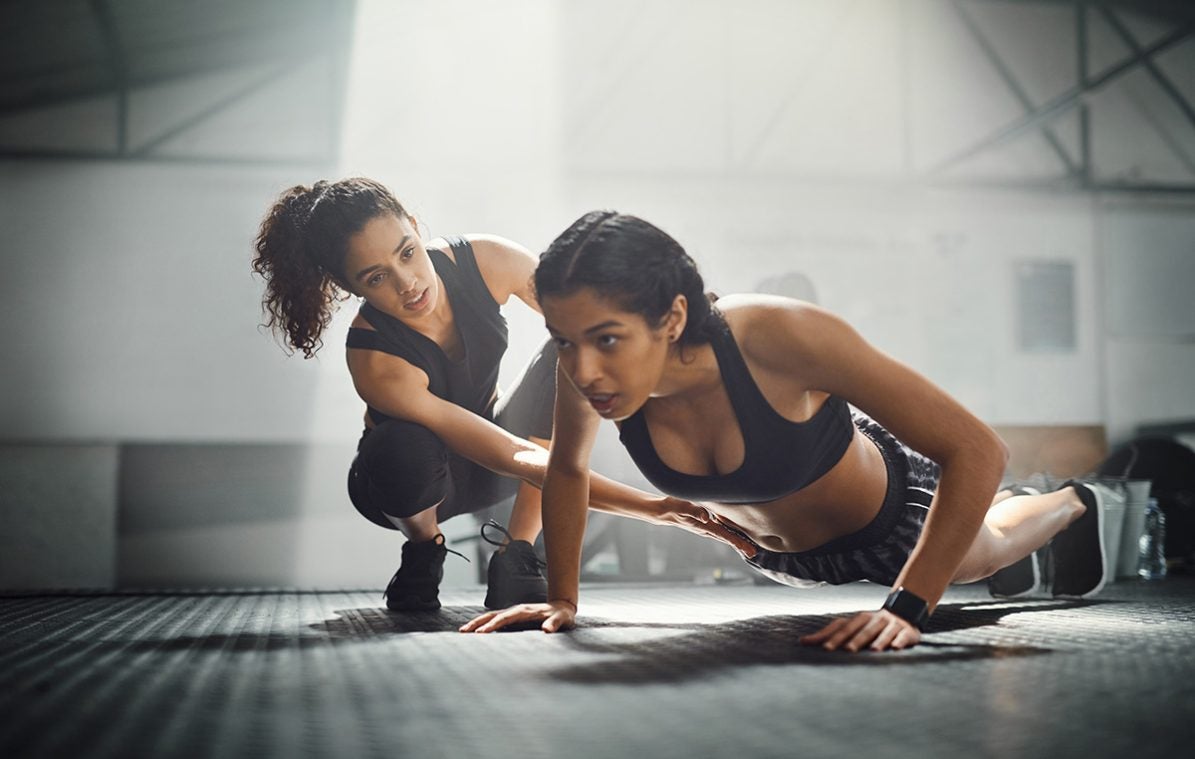Can’t Do a Full Push-up? With These 3 Tricks It Works
 ©Jay Yuno
©Jay Yuno
Your biceps are enviable, and no one can beat you at squats anytime soon. But when it comes to push ups, are you an absolute zero? Welcome to the club! Even though I’ve been going to the gym regularly for years, I couldn’t do a single push-up for ages. Until I realized that I had been training push ups incorrectly for years. Find out here what tricks finally helped me master push-ups. Read in advance what a push-up is and how to perform the exercise correctly.
Why do so many of us find it so hard to do push ups in the first place? One of the main reasons: When most people think of push-ups, they automatically think of chest training. Far from it: a push-up trains far more muscles. This is not an upper-body-only exercise. The whole body is active: From shoulders to biceps and triceps to core to glutes and thighs. Conversely, this means: If you don’t also tighten your butt and abdominal muscles during the push-up, you won’t get far. My first, basic tip is therefore: To prepare yourself optimally for push-ups, strengthen your entire musculature. Effective full body exercises include squats, lunges and rowing.
Additional tip: Feed your muscles with the right nutrients for even more push-up power – for example with our Whey Protein Powder or our Protein Bars*.
So here are three absolute game-changers that helped me finally manage proper (not kneeling!) push-ups after years of frustration:
#1 Perfect the deceleration movement during push-up
With push ups, most focus on the upward movement. The way down is easy, after all, thanks to gravity: you just have to let yourself plop down. This eccentric phase, when you lower your body weight in a controlled manner, is precisely the decisive one in the push-up.
If you want to learn push-ups properly, you should practice the downward deceleration movement well. Start by lowering yourself as slowly as possible from the high plank until first your chest and then your stomach are on the floor. Try to increase a little each time, performing the movement even slower and more controlled. Make sure to bring your entire body under tension. Activate your abdominal and gluteal muscles and push your heels away from you. If you train this exercise daily for a few weeks, you will build up more body tension, perfect the correct push-up technique and be optimally prepared for your first real push-up.
No push ups without a strong core: Here are the 11 best abdominal exercises for a stable core.
#2 Practice push ups with a resistance band
This trick is just awesome, especially if you have a hard time pushing yourself back up from the down position: You’ll need a short resistance band, often called a loop. Thread both arms through the loop and position the band slightly above your elbows. Now start in the high Plank with your hands under your shoulders and perform a push-up. The elbows are as close to the body as possible.
What happens? The resistance band stops the chest and automatically pushes the upper body back up. Start this exercise with a firm band and gradually reduce the intensity with lighter bands. Believe me: if you practice this variation for a few weeks, one day you’ll be able to do real push-ups without any support.
Here are more effective exercises with the fitness band!
#3 Start with elevated push-ups
Another effective exercise variation to slowly introduce you to classic push-ups is Incline Push-Ups. For this you need an elevation, for example an exercise bench, a table or a chair. In the beginning, even the wall does. The higher or steeper, the easier the execution.
Now place your hands shoulder-width apart on the elevation of your choice. As in a traditional push-up, the body forms a straight line from the feet to the head. Tighten your core, slowly lower your chest and press back up. Increase from time to time by choosing lower supports. By the way, you can also combine this exercise with a resistance band.
Typical push-up mistakes: read here what especially beginners constantly do wrong.
More things to know from foodspring:
- Learn pull-ups – With these 5 exercises it works
- Learn handstand in 9 simple steps
- The 7 best bodyweight exercises for your muscle growth
- Do Air Squats correctly
- Lunges (lunges) – the correct execution & variants
* Proteins contribute to muscle building and muscle maintenance.
Sources for this article
We at foodspring use only high-quality sources, including peer-reviewed studies, to support the facts within our articles. Read our editorial policy to learn more about how we fact-check and keep our content accurate, reliable, and trustworthy.

































